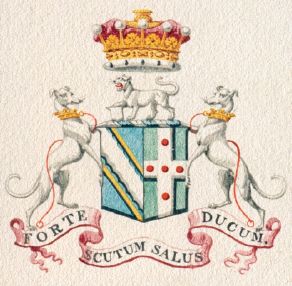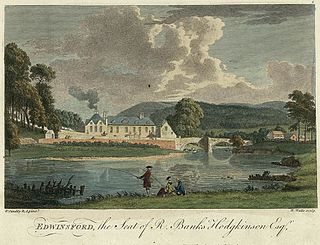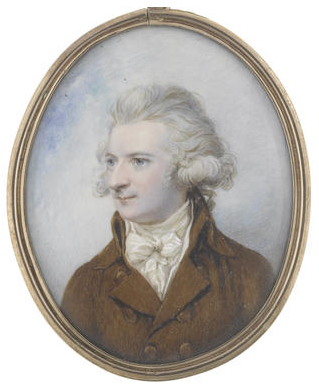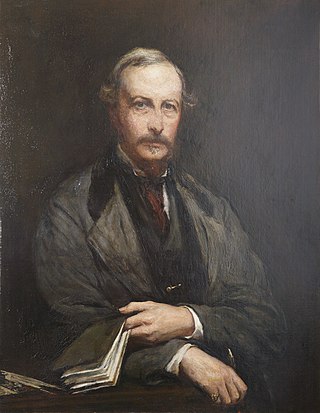
Baron Clinton is a title in the Peerage of England. Created in 1298 for Sir John de Clinton, it is the seventh-oldest barony in England.

Hugh Fortescue, 1st Earl Fortescue was a British peer, created Earl Fortescue in 1789.

The Cary family is an English aristocratic family with a branch in Ireland. The earliest known ancestor of the family is Sir Adam de Kari who was living in 1198. Sir John Cary purchased the Manor of Clovelly in the 14th century and established the family's status as members of the landed gentry. Various branches of the family were ennobled in the late 16th and early 17th centuries as Baron Hunsdon and Viscount Falkland.
The Drummond, later Williams-Drummond Baronetcy, of Hawthornden in the County of Mid Lothian, was a title in the Baronetage of the United Kingdom. It was created on 27 February 1828 for John Forbes Drummond. In accordance with the special reminder, the baronetcy passed to his son-in-law Francis Walker, who had assumed the additional name of Drummond upon his marriage in 1810. The third Baronet assumed the surname of Williams in lieu of that of Walker in 1858 under the terms of the will of his father-in-law, Sir James Hamlyn-Williams, 3rd Baronet 'of Clovelly'. The fourth Baronet served as Lord Lieutenant of Carmarthenshire. The title became extinct on the death of the sixth Baronet in 1976.

Sopley is a village and civil parish situated in the New Forest National Park of Hampshire, England. It lies on the old main road from Christchurch to Ringwood, on the east bank of the River Avon. The parish extends east as far as Thorny Hill and borders the parishes of Bransgore and Burton to the south and west respectively. It lies down the road from a small hamlet called Ripley. It includes the hamlets of Shirley, Avon and Ripley. The area is mainly rural with less than 300 dwellings.
Lieutenant-Colonel Henry Edward Hamlyn-Fane, known as Henry Fane until 1861, was a British soldier and Conservative politician.

Charles Noel Noel, 1st Earl of Gainsborough, known as Charles Edwardes until 1798, as Charles Noel between 1798 and 1823 and as the Lord Barham between 1823 and 1841, was a British peer and Whig politician.

Clovelly Court is a privately owned country house in Clovelly, Devon. The house and adjacent stable block are Grade II listed buildings. The gardens and parts of the estate are open to the public.

Sir Nicholas Williams, 1st Baronet was a British politician.

Creedy is an historic estate in the parish of Sandford, near Crediton in Devon. It is named from its location on the west side of the River Creedy. It was the seat of the Davie family from about 1600 until the late 20th century. The mansion house on the estate has been called at various times New House, Creedy House, and as presently, Creedy Park. It was first built in about 1600, rebuilt in 1846, burnt down in 1915 and rebuilt 1916–21. It is surrounded by a large park, the boundary of which is enclosed by a stone and brick wall several miles long.

Sir James Hamlyn, 1st Baronet (1735–1811) of Clovelly Court in Devon, and of Edwinsford, Carmarthenshire, Wales, was a Member of Parliament (MP) for Carmarthen 1793–1802. He served as Sheriff of Devon in 1767–8. He was created a baronet in 1795. He not only inherited a large estate in Devon from his wealthy childless great-uncle, but also married a wealthy Welsh heiress.

Avon Tyrrell is an historic manor within the parish of Sopley, Hampshire. It is situated within the New Forest, near Christchurch. The present manor house was built in 1891 by John Manners-Sutton, 3rd Baron Manners (1852–1927).

Zachary Hamlyn (1677–1759), of Clovelly and Woolfardisworthy, three miles south-east of Clovelly, Devon, was a lawyer of Lincoln's Inn and thought to be the first Clerk of the Journals of the House of Commons. He made a large fortune and in 1738 purchased the manor of Clovelly from the last of the Cary family, longtime lords of the manor, and made Clovelly Court his residence.

Sir John Cary, of Devon, was a judge who rose to the position of Chief Baron of the Exchequer (1386–88) and served twice as Member of Parliament for Devon, on both occasions together with his brother, Sir William Cary, in 1363/64 and 1368/69.
The Manor of Clovelly is a historic manor in North Devon, England. Within the manor are situated the manor house known as Clovelly Court, the parish church of All Saints, and the famous picturesque fishing village of Clovelly. The parish church is unusually well-filled with well-preserved monuments to the lords of the manor, of the families of Cary, Hamlyn, Fane, Manners and Asquith. In 2015 the Rous family, direct descendants via several female lines of Zachary Hamlyn (1677–1759) the only purchaser of Clovelly since the 14th century, still own the estate or former manor, amounting to about 2,000 acres, including Clovelly Court and the advowson of the parish church, and the village of Clovelly, run as a major tourist attraction with annual paying visitor numbers of about 200,000.

Edward Yarde (1669–1735), of Churston Court in the parish of Churston Ferrers in Devon was a Member of Parliament for Totnes in Devon 1695-1698.

Yeo Vale is an historic estate in the parish of Alwington in North Devon, England. The grade II listed mansion house known as Yeo Vale House, situated 1 mile east of Alwington Church and 3 miles south-west of Bideford, incorporating a 15th-century gatehouse, was demolished in 1973, having been abandoned as a residence in 1938 and having fallen into a dilapidated state. it was situated in the valley of the River Yeo, a small river flowing into the River Torridge immediately above Bideford. The barton or farmhouse survives, to which was attached the mansion house, together with various out-buildings and stone walls. A private mediaeval chapel was formerly attached to the mansion house and in the early 18th century was demolished and rebuilt as a folly on a hill about 1/4 mile south of the mansion house. It survives today as a ruin overgrown with trees and ivy.

Sir John Walrond Walrond, 1st Baronet, of Bradfield House, Uffculme in Devon, was a British Conservative Party politician.

Ambrose St John (1760–1822) of Prior Park, Berkshire and The Close, Winchester, Hampshire, was a Member of Parliament for Callington in Cornwall and an officer in the Worcestershire Militia.
Sir James Hamlyn Williams, 3rd Baronet was a Welsh politician.















